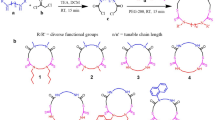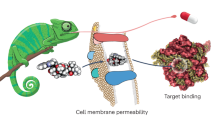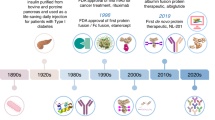Abstract
The potential utility of synthetic macrocycles (MCs) as drugs, particularly against low-druggability targets such as protein-protein interactions, has been widely discussed. There is little information, however, to guide the design of MCs for good target protein–binding activity or bioavailability. To address this knowledge gap, we analyze the binding modes of a representative set of MC–protein complexes. The results, combined with consideration of the physicochemical properties of approved macrocyclic drugs, allow us to propose specific guidelines for the design of synthetic MC libraries with structural and physicochemical features likely to favor strong binding to protein targets as well as good bioavailability. We additionally provide evidence that large, natural product–derived MCs can bind targets that are not druggable by conventional, drug-like compounds, supporting the notion that natural product–inspired synthetic MCs can expand the number of proteins that are druggable by synthetic small molecules.
This is a preview of subscription content, access via your institution
Access options
Subscribe to this journal
Receive 12 print issues and online access
$259.00 per year
only $21.58 per issue
Buy this article
- Purchase on Springer Link
- Instant access to full article PDF
Prices may be subject to local taxes which are calculated during checkout





Similar content being viewed by others
References
Hopkins, A.L. & Groom, C.R. The druggable genome. Nat. Rev. Drug Discov. 1, 727–730 (2002).
Berg, T. Small-molecule inhibitors of protein-protein interactions. Curr. Opin. Drug Discov. Devel. 11, 666–674 (2008).
Buchwald, P. Small-molecule protein-protein interaction inhibitors: therapeutic potential in light of molecular size, chemical space, and ligand binding efficiency considerations. IUBMB Life 62, 724–731 (2010).
Whitty, A. & Kumaravel, G. Between a rock and a hard place? Nat. Chem. Biol. 2, 112–118 (2006).
Wells, J.A. & McClendon, C.L. Reaching for high-hanging fruit in drug discovery at protein-protein interfaces. Nature 450, 1001–1009 (2007).
Hajduk, P.J. & Greer, J. A decade of fragment-based drug design: strategic advances and lessons learned. Nat. Rev. Drug Discov. 6, 211–219 (2007).
Scott, D.E. et al. Using a fragment-based approach to target protein-protein interactions. ChemBioChem 14, 332–342 (2013).
Morelli, X., Bourgeas, R. & Roche, P. Chemical and structural lessons from recent successes in protein-protein interaction inhibition (2P2I). Curr. Opin. Chem. Biol. 15, 475–481 (2011).
Basse, M.J. et al. 2P2Idb: a structural database dedicated to orthosteric modulation of protein-protein interactions. Nucleic Acids Res. 41, D824–D827 (2013).
Singh, J., Petter, R.C., Baillie, T.A. & Whitty, A. The resurgence of covalent drugs. Nat. Rev. Drug Discov. 10, 307–317 (2011).
Walensky, L.D. et al. Activation of apoptosis in vivo by a hydrocarbon-stapled BH3 helix. Science 305, 1466–1470 (2004).
Murray, J.K. & Gellman, S.H. Targeting protein-protein interactions: lessons from p53/MDM2. Biopolymers 88, 657–686 (2007).
Raj, M., Bullock, B.N. & Arora, P.S. Plucking the high hanging fruit: a systematic approach for targeting protein-protein interactions. Bioorg. Med. Chem. 21, 4051–4057 (2013).
Driggers, E.M., Hale, S.P., Lee, J. & Terrett, N.K. The exploration of macrocycles for drug discovery—an underexploited structural class. Nat. Rev. Drug Discov. 7, 608–624 (2008).
Wessjohann, L.A., Ruijter, E., Garcia-Rivera, D. & Brandt, W. What can a chemist learn from nature's macrocycles?—a brief, conceptual view. Mol. Divers. 9, 171–186 (2005).
Marsault, E. & Peterson, M.L. Macrocycles are great cycles: applications, opportunities, and challenges of synthetic macrocycles in drug discovery. J. Med. Chem. 54, 1961–2004 (2011).
Mallinson, J. & Collins, I. Macrocycles in new drug discovery. Future Med. Chem. 4, 1409–1438 (2012).
Yu, X. & Sun, D. Macrocyclic drugs and synthetic methodologies toward macrocycles. Molecules 18, 6230–6268 (2013).
Giordanetto, F. & Kihlberg, J. Macrocyclic drugs and clinical candidates: what can medicinal chemists learn from their properties? J. Med. Chem. 57, 278–295 (2014).
Ganesan, A. The impact of natural products upon modern drug discovery. Curr. Opin. Chem. Biol. 12, 306–317 (2008).
Lipinski, C.A. Drug-like properties and the causes of poor solubility and poor permeability. J. Pharmacol. Toxicol. Methods 44, 235–249 (2000).
Vistoli, G., Pedretti, A. & Testa, B. Assessing drug-likeness—what are we missing? Drug Discov. Today 13, 285–294 (2008).
Brandt, W., Haupt, V.J. & Wessjohann, L.A. Chemoinformatic analysis of biologically active macrocycles. Curr. Top. Med. Chem. 10, 1361–1379 (2010).
Bockus, A.T., McEwen, C.M. & Lokey, R.S. Form and function in cyclic peptide natural products: a pharmacokinetic perspective. Curr. Top. Med. Chem. 13, 821–836 (2013).
White, T.R. et al. On-resin N-methylation of cyclic peptides for discovery of orally bioavailable scaffolds. Nat. Chem. Biol. 7, 810–817 (2011).
Brenke, R. et al. Fragment-based identification of druggable 'hot spots' of proteins using Fourier domain correlation techniques. Bioinformatics 25, 621–627 (2009).
Landon, M.R., Lancia, D.R. Jr., Yu, J., Thiel, S.C. & Vajda, S. Identification of hot spots within druggable binding regions by computational solvent mapping of proteins. J. Med. Chem. 50, 1231–1240 (2007).
Kozakov, D. et al. Structural conservation of druggable hot spots in protein-protein interfaces. Proc. Natl. Acad. Sci. USA 108, 13528–13533 (2011).
Gaulton, A. et al. ChEMBL: a large-scale bioactivity database for drug discovery. Nucleic Acids Res. 40, D1100–D1107 (2012).
Jorgensen, W.L. The many roles of computation in drug discovery. Science 303, 1813–1818 (2004).
Lo Conte, L., Chothia, C. & Janin, J. The atomic structure of protein-protein recognition sites. J. Mol. Biol. 285, 2177–2198 (1999).
Nayal, M. & Honig, B. On the nature of cavities on protein surfaces: application to the identification of drug-binding sites. Proteins 63, 892–906 (2006).
Ciulli, A., Williams, G., Smith, A.G., Blundell, T.L. & Abell, C. Probing hot spots at protein-ligand binding sites: a fragment-based approach using biophysical methods. J. Med. Chem. 49, 4992–5000 (2006).
DeLano, W.L. Unraveling hot spots in binding interfaces: progress and challenges. Curr. Opin. Struct. Biol. 12, 14–20 (2002).
Landon, M.R., Lancia, D.R. Jr., Yu, J., Thiel, S.C. & Vajda, S. Identification of hot spots within druggable binding regions by computational solvent mapping of proteins. J. Med. Chem. 50, 1231–1240 (2007).
Chuang, G.Y. et al. Binding hot spots and amantadine orientation in the influenza A virus M2 proton channel. Biophys. J. 97, 2846–2853 (2009).
Hall, D.H. et al. Robust identification of binding hot spots using continuum electrostatics: application to hen egg-white lysozyme. J. Am. Chem. Soc. 133, 20668–20671 (2011).
Buhrman, G. et al. Analysis of binding site hot spots on the surface of Ras GTPase. J. Mol. Biol. 413, 773–789 (2011).
Zerbe, B.S., Hall, D.R., Vajda, S., Whitty, A. & Kozakov, D. Relationship between hot spot residues and ligand binding hot spots in protein-protein interfaces. J. Chem. Inf. Model. 52, 2236–2244 (2012).
Hall, D.R., Ngan, C.H., Zerbe, B.S., Kozakov, D. & Vajda, S. Hot spot analysis for driving the development of hits into leads in fragment-based drug discovery. J. Chem. Inf. Model. 52, 199–209 (2012).
Golden, M.S. et al. Comprehensive experimental and computational analysis of binding energy hot spots at the NF-κB essential modulator/IKKβ protein-protein interface. J. Am. Chem. Soc. 135, 6242–6256 (2013).
Roe, S.M. et al. Structural basis for inhibition of the Hsp90 molecular chaperone by the antitumor antibiotics radicicol and geldanamycin. J. Med. Chem. 42, 260–266 (1999).
Hajduk, P.J., Huth, J.R. & Fesik, S.W. Druggability indices for protein targets derived from NMR-based screening data. J. Med. Chem. 48, 2518–2525 (2005).
Landon, M.R. et al. Novel druggable hot spots in avian influenza neuraminidase H5N1 revealed by computational solvent mapping of a reduced and representative receptor ensemble. Chem. Biol. Drug Des. 71, 106–116 (2008).
Rand, A.C. et al. Optimizing PK properties of cyclic peptides: the effect of side chain substitutions on permeability and clearance. Medchemcomm. 3, 1282–1289 (2012).
Hopkins, A.L., Groom, C.R. & Alex, A. Ligand efficiency: a useful metric for lead selection. Drug Discov. Today 9, 430–431 (2004).
Hajduk, P.J. Fragment-based drug design: how big is too big? J. Med. Chem. 49, 6972–6976 (2006).
Veber, D.F. et al. Molecular properties that influence the oral bioavailability of drug candidates. J. Med. Chem. 45, 2615–2623 (2002).
Wu, C.Y. & Benet, L.Z. Predicting drug disposition via application of BCS: transport/absorption/ elimination interplay and development of a biopharmaceutics drug disposition classification system. Pharm. Res. 22, 11–23 (2005).
Vieth, M. et al. Characteristic physical properties and structural fragments of marketed oral drugs. J. Med. Chem. 47, 224–232 (2004).
Lee, B. & Richards, F.M. The interpretation of protein structures: estimation of static accessibility. J. Mol. Biol. 55, 379–400 (1971).
Hartshorn, M.J. et al. Diverse, high-quality test set for the validation of protein-ligand docking performance. J. Med. Chem. 50, 726–741 (2007).
Kozakov, D. et al. Structural conservation of druggable hot spots in protein-protein interfaces. Proc. Natl. Acad. Sci. USA 108, 13528–13533 (2011).
Hall, D.R., Ngan, C.H., Zerbe, B.S., Kozakov, D. & Vajda, S. Hot spot analysis for driving the development of hits into leads in fragment-based drug discovery. J. Chem. Inf. Model. 52, 199–209 (2012).
Mann, H. & Whitney, D. On a test of whether one of two random variables is stochastically larger than the other. Ann. Math. Stat. 18, 50–60 (1947).
Anderson, T. & Darling, D. Asymptotic theory of certain “goodness-of-fit” criteria based on stochastic processes. Ann. Math. Stat. 23, 193–212 (1952).
Acknowledgements
This research was supported by US National Institutes of Health grants GM094551 to A.W., S.V. and J.A.P. and GM064700 to S.V. and NIH diversity supplement GM094551-01S1 to E.A.V.
Author information
Authors and Affiliations
Contributions
A.W., S.V. and D.K. conceived of and directed the study; E.A.V. performed the calculations and analysis, with advice from D.B.; S.C., under the supervision of J.A.P., analyzed the physicochemical properties of the MC drugs; and A.W. and E.A.V. wrote the manuscript with input from S.V., D.K. and S.C.
Corresponding authors
Ethics declarations
Competing interests
The authors declare no competing financial interests.
Supplementary information
Supplementary Text and Figures
Supplementary Results, Supplementary Figures 1–6 and Supplementary Tables 1–7. (PDF 2233 kb)
Rights and permissions
About this article
Cite this article
Villar, E., Beglov, D., Chennamadhavuni, S. et al. How proteins bind macrocycles. Nat Chem Biol 10, 723–731 (2014). https://doi.org/10.1038/nchembio.1584
Received:
Accepted:
Published:
Issue Date:
DOI: https://doi.org/10.1038/nchembio.1584
This article is cited by
-
Molecular chameleons in drug discovery
Nature Reviews Chemistry (2023)
-
Repurposing host-guest chemistry to sequester virulence and eradicate biofilms in multidrug resistant Pseudomonas aeruginosa and Acinetobacter baumannii
Nature Communications (2023)
-
Enantiocontrolled macrocyclization by encapsulation of substrates in chiral capsules
Nature Synthesis (2023)
-
Progress in programmed cell death-1/programmed cell death-ligand 1 pathway inhibitors and binding mode analysis
Molecular Diversity (2023)
-
Synthesis and direct assay of large macrocycle diversities by combinatorial late-stage modification at picomole scale
Nature Communications (2022)



